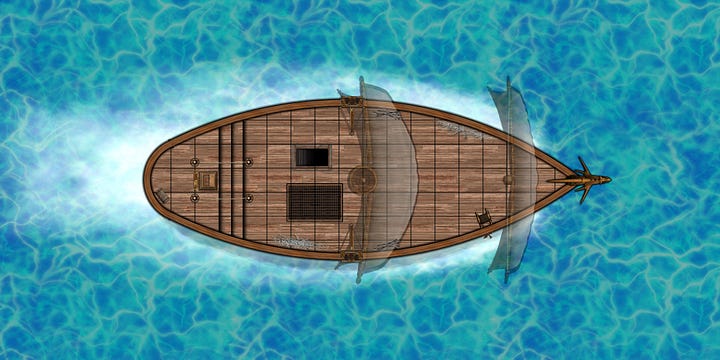Watch Well Games: Issue #21
Whether making maps or creating games, we'll explore a bit of the human side of ttRPGs.
Welcome to our RPG community newsletter!
It’s been…a week, so this will be brief. Also, my backlog of interviews and reviews has dried up, so if you know a creator in the ttRPG realm who may want to contribute, send ‘em my way.
Here’s what we have for you today:
Cartographer Schlau (Light in Darkness Gaming) shares part 1 of his journey into mapmaking.
“Make a game with me” - Week 2: Sentient robots ask, “How do I become more human?”
I’m K.J. - hobbyist writer, creator, long-time GM, and player who loves supporting others in the RPG community. I also playtest and proofread scenarios. I enjoy playing bass guitar and eating dark chocolate but not simultaneously.
I started Watch Well Games at the end of 2023 to build a community around the hobby we have in common - RPGs. Join me as I share what I learn along the way.
My Journey into Cartography
by Schlau (Light in Darkness Gaming)
My journey to becoming a cartographer started when I was in the 2nd grade. One day, while driving us home, my dad taught me that 6x6=36. Not 1x2=2. He was always giving me something to reach for, not just handing me something easy. My dad was great like that.
Math became my favorite subject, not that I am some sort of prodigy. I’m not at all. I just enjoy how numbers interact to make new numbers. This is the first ingredient that led to cartography.
When I was a little older, my dad and I lived in a duplex. We had extra furniture from somewhere. So I had a whole room to build a furniture/blanket/pillow fortress out of. I built and rebuilt it over time, making little rooms and entrances, and especially trying to make hidden rooms for my secret meetings (with my army of toys). The idea of floorplans was developing.
I also took up drawing, and after watching the old Knight Rider show, I wanted to design a truck and trailer setup with living quarters and my Lamborghini Countach. (The concept of having a job to pay for gas and food didn’t occur to 10 year-old me at the time.) That led to designing a neighborhood where I could have all my friends and family live on the same street. And, of course, as I interviewed the different people on what rooms they would like to have in their custom homes, I found out that nobody wanted the same thing. I started laying out different floor plans for their individual requests. This was hard, but the challenge was exciting.
When I was 13, I met my uncle Mac for the first time. Mac was a math genius, having done work on Navy ships with measurements and designs that needed precise levels of exactitude. He introduced me to Chaos Theory by giving me a book about it. He took my passion for math and science to a new level.
In 10th grade I enrolled in a design class focused on the science of construction, perspective, and proportion. I loved that class. We made all kinds of blueprints for anything from simple block shapes to house plans. I aced that class like it was kindergarten finger painting, and I was a 7-armed Bob Ross (seriously, have you seen this guy paint!).
Near the end of my school years, I discovered ttRPGs. What an amazing idea - using creativity and design together to make a new world come alive, sculpting it with decisions and stories!
And there were maps!
After graduating high school, I really didn’t have a lot to do with anything concerning cartography for quite some time. I was busy making money to pay for gas and food. A few years later, I got married, and when our kids were old enough to understand the basics of ttRPGs, I introduced them to a homebrew game system I created. I made maps of countries, cities, buildings, caves, and anything else the adventure needed.
We eventually found players at a local game shop, and had a litany of adventures. It was great. Then, like the rest of the world, covid happened. My family and I still played RPGs at home, but we wanted community. We delved into the online VTT space. It began when my brother-in-law invited us to play a 5e adventure. I was amazed at all the options for VTT maps, and I started making maps for online games we played.
I started with GIMP and some other free resources, scanning in what I had drawn. Then I found some paid resources that I really enjoyed, some of which I still use either occasionally or almost daily. I would start making a map in one software, then export it to another for added details or functions, then import it back or export once again to finish the map using a third resource.
I have started selling my maps on DriveThruRPG, and I will soon open my own Patreon. I have invested heavily into my hobby, and I don’t expect to get rich or even replace my day job, but if it covers the expenses of investment, and maybe a little extra, I will be ecstatic.
Next week, I will cover my chosen software options.
Find Schlau’s maps on DriveThruRPG:
Find Schlau’s Free Map for This Week and all His Others Here:


A brief interruption
The Watch Well Games Creators Spotlight Bundle
16 creators. 13 Pocket Quest games. One bundle that’s easy to grab up and dive into. More content = more gaming.
“Make a game with me” - Week 2
Continuing to make a game with you the audience.
If you missed last week’s newsletter, here’s a refresher:
First, what is all of this? Very much an experimental experience, this will hopefully be an interactive, game-making journey where YOU can participate if it strikes your fancy, giving input on a rules-lite, pocket ttRPG. You can also just lurk and be amused by whatever happens - or doesn’t.
How long will it last? It’s too early to tell. Let’s enjoy the journey before appreciating the final destination, shall we?
Anything else? Probably. We can address that in future “Make a game with me” sessions.
So, where are we at going into Week 2?
To build out our rules-lite RPG, we want to finalize a few of the primary details (knowing these may need to change if playtesting proves it so).
Decided on from Week 1:
Genre and setting: hypothetical, soft sci-fi with (hopefully) loads of sarcasm and humor on what defines “being human.”
Major themes and basic lore: Robots/AI becoming sentient and trying to “become human.”
Group ttRPG with a GM (I could easily modify this to solo or 1-to-1 though.)
Base randomizer for generating situations, events, challenges, and obstacles: handful D6s, up to 6D6 possibly.
Basic resolution mechanics: I’m still working on this, but I will be using my Start With Six (SW6) game engine that I began casually working on last summer.
Character creation: TBD
Character development and growth: I think the goal of this small ttRPG should be for the player-characters’ robots/AIs to “become” as human as possible. The success of this goal can be measured by PCs reaching the top of Maslow’s hierarchy of needs via having as many experiences and objectives completed. (Crash Course helped me get through college, so I’ll plug in this video reference right here.)
From this point: We’ll place some obstacles in the way, since this happens to humans as well. These can cause the PCs’ robots/AI to go down the pyramid, requiring that they reassess their approach or method, slowing them down or requiring that they go through an experience again - something like this.
Above: A humorous look at Maslow’s hierarchy of needs pyramid
Decide on for Week 2:
This week’s questions that we need to answer:
Using the character development and growth, as well as other decision points listed above, what should be included on the character sheet?
Character creation: What should be generated from players, and what should be generated from random roll tables?
Where in the setting’s world should the characters start? (There could be multiple options here, where each location provides a different adventure and set of challenges.)
What kind of obstacles and challenges should we add? Should these be generated from random roll tables or the GM can pull these out using the general lore of the game?
How can characters overcome these obstacles and challenges? Will there be violence, weapons,and fighting or should PCs use other skills, traits, etc. to gain the upper hand?
What determines success? Rolling under versus a set challenge rating, opposed rolls, or something else?
Should characters be able to die? (They are robots/AI after all.)
How co-operative should this ttRPG be - where successes are shared and everyone benefits, or is this competitive where it’s every robot for themself?
That’s it for this week! Remember:
Support human creators and writers. Buy their games, play their games, leave a kind review, then let others know about the games. As always, thanks for joining me! Newsletters are always free, so spread the good word.















Perhaps the AI start at their original mainframe or operating system, which would have a skin.
Perhaps they roll half their stats randomly and spend points on the others. They decide which ones they roll/spend.
Perhaps the company that created them is their main adversary and always on the run from them. They can be tracked but has lag. So they have to keep moving.
Maybe combat is opposed rolls plus skills .... difference is amount of "damage"
Maybe damage means they lose skills/stats as their software is corrupted.
Perhaps the settings is in layers ... each level having a different skin. You can go left/right/forward/back on the same level or up and down to different levels ... allowing 3d movement.
Maybe you have to hack different data fortresses to unlock new more human aspects of your software (also adds stats). Maybe these data forts have security programs like denizens, traps and locks and have an alarm system that summons defence software which can be AI.
Hope that helps 😀